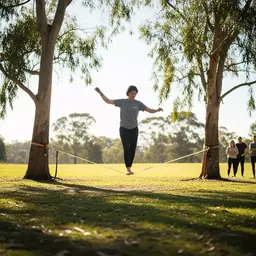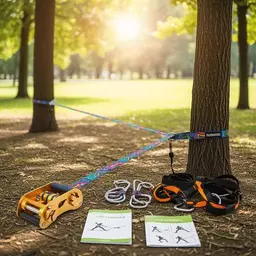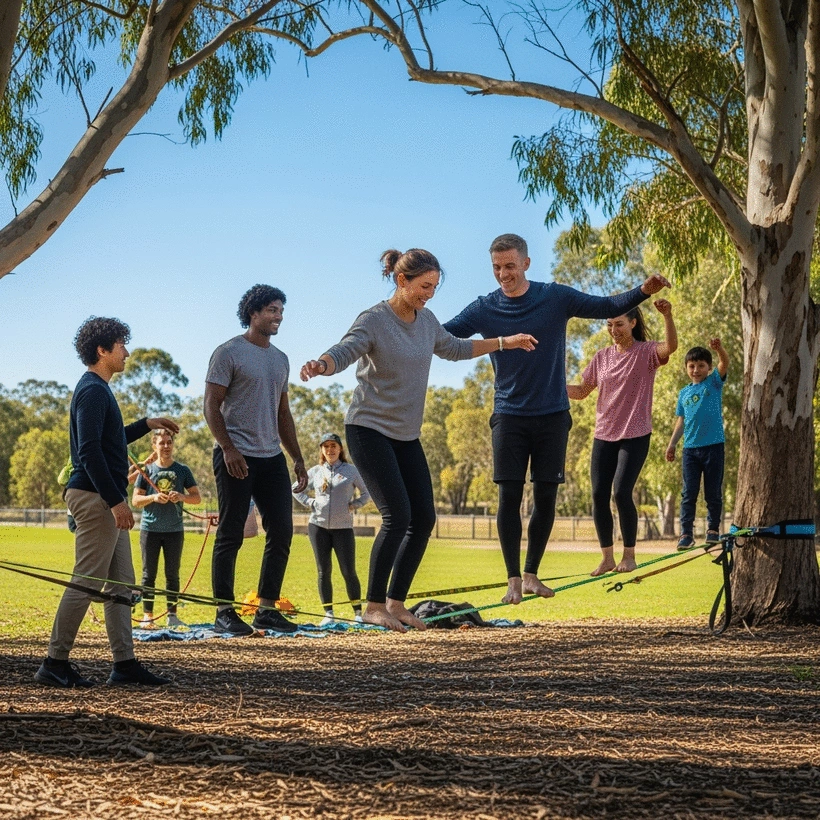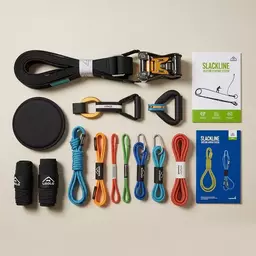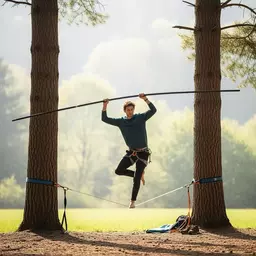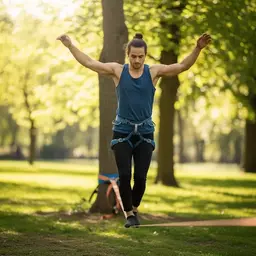Slackline Safety Tips for Beginners
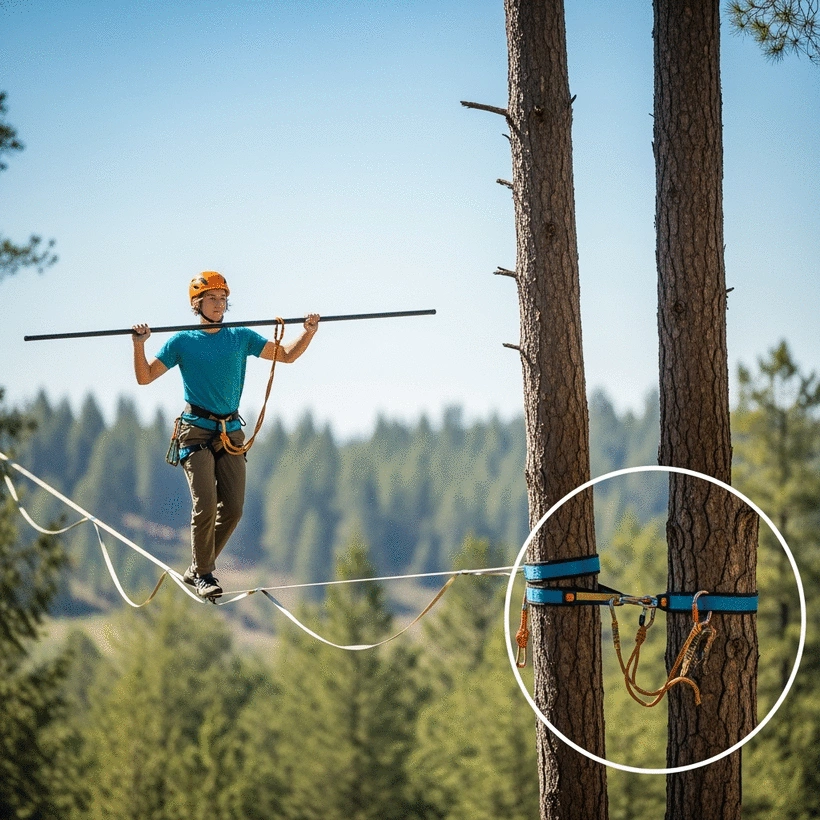
Have you ever stood on a slackline, heart racing, as you teetered on the edge of balance? As a beginner, the excitement can be both thrilling and daunting. By prioritizing safety, you can transform that adrenaline rush into a joyful experience. Here’s what you’ll learn about slackline safety and how to set yourself up for success!
What You Will Learn
- The significance of safety practices for beginners to enhance confidence and enjoyment.
- Common risks associated with slacklining, including bruises and sprains.
- Essential safety precautions for setting up your slackline correctly.
- Key takeaways for maintaining safety and building skills progressively.
- Practical actions to engage with the slacklining community and improve your skills.
Slackline Safety for Beginners: Key Areas & Risks
Understanding the critical areas of slackline safety and the potential risks involved is crucial for a successful and injury-free experience. This visual breaks down the core elements to consider.
Why Safety Matters: Foundation for Beginners
- Establishes confidence
- Reduces injury risk
- Encourages positive experience
Key Setup Precautions
- Safe location choice
- Correct rigging techniques
- Ground anchors for stability
Potential Risks for New Users
- Bruises (common)
- Sprains (improper landings)
- Severe accidents (rare)
Key Takeaways for Safe Slacklining
- Understand proper setup & conditions
- Regularly check gear
- Start low & short, gradually progress
- Connect with fellow slackliners
Understanding Slackline Safety: The Importance for Beginners
Starting your slacklining journey? Safety should be your top priority! At Slackline Shop Australia, we believe that understanding slackline safety is essential for all beginners. It not only enhances your experience but also ensures that you can fully enjoy the thrill of balancing on the line without unnecessary worries.
When you're up on that line, there’s a world of excitement beneath your feet! But with that excitement comes an important responsibility—to know and respect the safety measures that can keep you injury-free. Remember, every slackliner, regardless of skill level, should prioritize safety in every session. For comprehensive guidelines on safe slacklining practices, you can refer to resources like the CIRSA Slackline Safety Guidelines.
Why Safety Matters When Starting Slacklining
As a newcomer to slacklining, it’s crucial to comprehend the significance of safety practices. When you start, you may feel a rush of adrenaline, but understanding the safety aspects makes that rush enjoyable rather than dangerous. By taking the time to learn proper safety protocols, you can build a solid foundation for your slacklining skills.
- Establishes confidence in your abilities
- Reduces the risk of injuries
- Encourages a positive and enjoyable experience
Emphasizing safety not only benefits you but also creates a supportive environment for other slackliners. When everyone is aware of and practices safety measures, it fosters a culture of respect and responsibility within the community. Further insights into safe equipment and practices can be found in documents such as the Wisconsin Department of Public Instruction's Slackline Safety guidance.
The Risks Involved in Slacklining for New Users
While slacklining is an exhilarating sport, it does come with its own set of risks—especially for beginners. Falling off the line can lead to minor bruises, sprains, or, in rare cases, more serious injuries. Understanding these risks can help you stay alert and prepared!
- Bruises: Common for beginners when falling off the line.
- Sprains: Can occur due to improper landings or abrupt movements.
- Severe accidents: Though rare, they can happen, especially without proper safety measures.
At Slackline Shop Australia, we want you to enjoy your slacklining journey while minimizing risks. By being aware of these potential problems, you can take proactive steps to stay safe as you learn. Remember, the goal is to have fun and grow your skills without unnecessary setbacks!
Essential Safety Precautions for a Successful Setup
Now that we've established the importance of safety, let’s explore the essential precautions you need to implement when setting up your slackline. A successful setup is the first step toward a safe and enjoyable slacklining experience. For detailed safety information, the Slackline International Safety Guidelines are an invaluable resource.
- Choose a safe and appropriate location.
- Ensure correct rigging techniques.
- Consider using ground anchors for added stability.
Each of these points contributes to creating a secure environment where you can practice and improve your slacklining skills. Let’s dive deeper into the first point—choosing the right location!
Quick Safety Check!
Before you step onto the slackline, make sure you’ve gone through this quick safety checklist:
- Have you chosen a safe and clear area for setup?
- Is your slackline rigged properly and securely?
- Are you wearing appropriate personal protective equipment (PPE)?
- Have you checked the condition of your gear to ensure it’s safe to use?
By answering these questions, you’re ensuring a safer and more enjoyable slacklining experience!
Frequently Asked Questions About Slackline Safety
- Why is slackline safety important for beginners?
- Safety is crucial for beginners to build confidence, reduce the risk of injuries, and ensure a positive and enjoyable experience while learning the sport.
- What are the common risks associated with slacklining for new users?
- Common risks include bruises from falling, sprains from improper landings, and, though rare, more severe accidents if proper safety measures are not followed.
- What essential precautions should I take when setting up a slackline?
- Essential precautions include choosing a safe and appropriate location, ensuring correct rigging techniques, and considering ground anchors for added stability.
- How can I gradually improve my slacklining skills safely?
- To improve safely, start with low heights and shorter lines, gradually increasing as your confidence and balance improve. Regularly check your gear and connect with experienced slackliners for tips.
- Where can I find more information and support for slacklining?
- You can join the Slackline Shop Australia community, follow them on social media, participate in local meetups or workshops, and explore local slackline parks for guidance and opportunities to connect with other enthusiasts.
Recap of Essential Slackline Safety Tips for Beginners
As we wrap up our discussion on slackline safety, it's crucial to remember that prioritizing safety is key to enjoying this exhilarating sport. Whether you’re just starting or looking to sharpen your skills, keeping these fundamental guidelines in mind will help you navigate the slacklining world more confidently. Let’s quickly go over the essential safety tips that I always recommend!
- Always choose a safe and clear location for your slackline setup.
- Ensure that your slackline is rigged correctly and securely.
- Use ground anchors for added stability to prevent accidents.
- Wear appropriate personal protective equipment (PPE) to minimize injury risks.
- Practice regularly to build your balance and skills gradually.
By following these tips, you’re setting yourself up for success and safety. Slacklining is all about balance and enjoyment, so make sure you create a secure environment to thrive in this adventure!
Key Takeaways for Successful and Safe Slacklining
Reflecting on our journey through slackline safety, here are some key takeaways that every beginner should keep in mind:
- Understand the importance of proper setup and environmental conditions.
- Regularly check your gear for wear and tear.
- Start with low heights and shorter lines, gradually increasing as you gain confidence.
- Connect with fellow slackliners for support and tips.
These takeaways will not only enhance your safety but also enrich your overall slacklining experience. Remember, the more informed you are, the more enjoyable your journey will be!
Next Steps: Your Slackline Safety Journey Begins Here
Practical Actions to Implement Your Safety Knowledge
Now that you’re equipped with essential safety tips, it’s time to put that knowledge into action! Here are some practical steps to consider as you embark on your slacklining adventure:
- Scout potential locations to find the best slacklining spots in your area.
- Gather your slacklining gear and ensure it’s all in good condition.
- Set a specific day and time to practice, inviting friends to join for some motivation!
- Consider documenting your progress and experiences to share in our community.
Taking these steps will help you solidify your commitment to safety while also opening the door to new experiences and friendships!
Join the Slacklining Community for Ongoing Learning
The journey of slacklining doesn’t end after you’ve set up your line! I encourage you to join our Slackline Shop Australia community. Connecting with other enthusiasts can provide immense value. Here’s how to get started:
- Follow us on social media for tips, tricks, and community events.
- Participate in local slacklining meetups or workshops.
- Share your experiences and learn from others in our online forums.
Engaging with others can not only enhance your skills but also deepen your understanding of safety practices in slacklining!
Exploring Slackline Parks and Practice Areas
Lastly, consider checking out local slackline parks or practice areas. These spots often provide a perfect environment for both beginners and advanced slackliners. Here are some benefits:
- Access to well-maintained setups and proper rigging guidance.
- Opportunities to meet experienced slackliners who can offer tips.
- Structured environments that encourage practice and skill development.
Exploring these areas can lead to a more fulfilling slacklining journey. So, grab your gear and let’s take this adventure to new heights together!
Recap of Key Points
Here is a quick recap of the important points discussed in the article:
- Always choose a safe and clear location for your slackline setup.
- Ensure that your slackline is rigged correctly and securely.
- Use ground anchors for added stability to prevent accidents.
- Wear appropriate personal protective equipment (PPE) to minimize injury risks.
- Practice regularly to build your balance and skills gradually.
- Understand the importance of proper setup and environmental conditions.
- Regularly check your gear for wear and tear.
- Start with low heights and shorter lines, gradually increasing as you gain confidence.
- Connect with fellow slackliners for support and tips.
